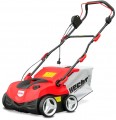Working width
The width of the strip processed by the aerator in one pass. The higher this indicator, the faster the device works, the fewer passes will have to be made to process a certain area. On the other hand,
a wide grip noticeably affects the dimensions of the entire structure and makes it difficult to work in hard-to-reach places, if not impossible. Therefore, when choosing a model in terms of working width, it is worth considering not only the overall dimensions of the site, but also its configuration and the presence of tight areas — sometimes it is preferable to sacrifice the performance of the aerator for the sake of its manoeuvrability and patency.
Number of depth settings
The number of nozzle depth adjustments provided in the design of the aerator. Note that we can talk not only about the depth, but also, in the case of scarifiers, about the height of processing (for more details, see above). Anyway, the
more depth (height) settings, the wider the choice of the operator, the more accurately he can choose the optimal value for a particular situation.
Working mechanism
The design of the working mechanism provided in the aerator, in other words, the number and types of working elements installed on the shaft. For verticutters (see "Type") such elements are blades, for scarifiers — spring teeth. For
combined models, in this case, the design of both working shafts is indicated, for example "14 knives / 20 spring teeth".
Bag volume
The total volume of the garbage collection bag provided with the aerator.
The larger the bag, the more garbage it can hold, the less often it will have to be emptied. On the other hand, the weight and dimensions of a capacious container will also be considerable (this is especially true for rigid varieties, in which the size does not depend on fullness — see "Bag Type"). Yes, and carrying too much garbage “with you” is not always convenient, especially with the small size and weight of the unit itself. Therefore, manufacturers, usually, choose this parameter taking into account the specifics of the use of the aerator. So, in low-power models designed for small areas, the volume of the bag is also small, and in high-performance professional devices it can exceed 50 liters.
Motor power
The power of the aerator motor, expressed in watts. Today, the watt is the common unit of power and is used for both electric and petrol models (see "Engine type"). In general, the
more powerful the motor, the higher the performance of the unit, the greater the depth of processing and the working width (see above) can be provided in the aerator; however, the consumption of electricity / fuel also directly depends on the power. Therefore, when choosing an engine for their equipment, manufacturers proceed from a reasonable compromise between these properties, and in general, engine power allows you to evaluate the performance of the unit and its suitability for large volumes of work.
Noise level
The noise level produced by the aerator during operation. It is worth noting that this indicator can be indicated in different ways: some manufacturers give the maximum noise level in the characteristics, others give average values \u200b\u200bduring normal operation, etc. Anyway, this information allows you to assess the noise level of the unit and, if necessary, provide protective measures — for example, get headphones in advance.
When evaluating specific loudness values, note that the decibel used to indicate the noise level is a non-linear value. Therefore, it is easiest to evaluate specific values using comparative tables. Here is a simplified table for the range that most modern aerators fit into:
70 dB — a conversation of several people in raised tones.
75 dB — high power vacuum cleaner.
80 dB — traffic noise on a busy street.
85 dB — motorcycle engine with muffler in close proximity;
90 dB — freight car at a distance of 7 – 10 m;
95 dB — noise in the subway car on the stage;
100 dB — industrial shop.

